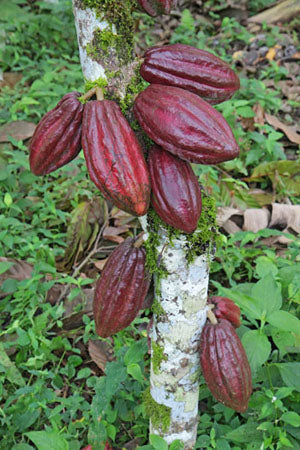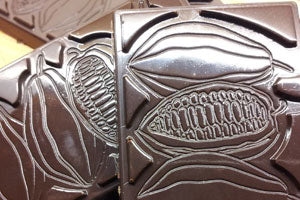What Is Raw Chocolate?
A question that we often get asked is "What is raw chocolate?" It's no wonder really, given that it's relatively new in the Western consciousness. So here's our definitive article on the subject.
The generally held view is that raw chocolate, in the context of what we do round these parts, relates to two key aspects. Both fundamental to raw chocolate and both fundamentally different to your average chocolate product.
Low Temperatures
 First up is the nature of the cacao itself, how it's produced and how it's processed. Specifically, when it comes to temperature through the processing. Typically, from bean to bar, your average choccie has gone through the mill, so to speak, being heated to temperatures as high as 200°F two, three, sometimes more times.
First up is the nature of the cacao itself, how it's produced and how it's processed. Specifically, when it comes to temperature through the processing. Typically, from bean to bar, your average choccie has gone through the mill, so to speak, being heated to temperatures as high as 200°F two, three, sometimes more times.
The processes involved include:
- Roasting the beans
- Extracting the butter & powder, through high temperature/pressure mechanical processing
- Conching - essentially kneeding and mixing the cocoa butter and powder at temperature
- Tempering - heating and cooling the chocolate to manipulate the crystal structure
Now anyone with a basic understanding of nutrition will realise that all this heating and cooling of the cacao will destroy nutrients, lots of them.
With raw cacao by contrast, the beans are never roasted, the extraction of the butter and powder is done on a small scale, under low temperatures, conching is not done and tempering is typically skipped also. See my blog post "To Temper or Not To Temper, That is the Question" for more thoughts on this topic.
Nothing Artificial
When it comes to the ingredients used to make raw chocolate, the big thing here is that raw chocolate will contain no refined cane sugar, no dairy, no wheat or gluten, no packers or bulking agents and no artificial additives, flavours, preservatives or colours. Think of it as chocolate without the junk.
What raw chocolate will contain is, low glycemic natural sweeteners such as coconut blossom sugar and Sweet Freedom, real fruit nuts and seeds. Proper ingredients you’d recognize and that don’t need numbers to categorise them.
Instead, here at Elements for Life we use Sweet Freedom (a low GI syrup made from fruit extracts), raw honey or Coconut Palm Sugar (a low GI sugar made the nectar of the coconut palm) in place of cane sugar or artificial sweeteners. A variety of super food ingredients, such as lucuma and maca can also be added to change the flavour and smoothness of your raw chocolates.
 Benefits Of Raw Chocolate
Benefits Of Raw Chocolate
Numerous studies have been coming out over the past few years that indicate that chocolate, more specifically dark chocolate, may have beneficial aspects to health. These include lowering risk of heart disease, lowering the risk of stroke, improving blood flow, as well as containing high levels of nutrients such as magnesium, antioxidants (easily destroyed by heat) and vitamins.
The studies have understandably focused on conventional chocolate, with the greatest benefits being associated with dark chocolate. In some studies, the potential benefits have been negated when milk or white chocolate is consumed instead.
We all instinctively know that eating foods that are less processed and closer to their original form is good for us. It is also now widely recognized that consumption of dairy products can cause mucous formation, affecting allergy suffers and asthmatics. Refined sugar consumption is strongly associated with diabetes and other chronic diseases.
Taking all of the above into account, stepping away from conventional chocolate, to purer, less processed raw chocolate is a logical and sensible step. Raw chocolate cuts out the bad aspects of chocolate, such as dairy, refined sugar and artificial junk, while also preserving nutrients from minimal heating.
Your average raw chocolate bar or product ticks many boxes when it comes to dietary considerations;
- The use of low glycemic natural sweeteners is good for all of us, particularly diabetics
- Cutting out dairy means raw chocolate is suitable for vegans and lactose intolerance
- No wheat or gluten, such as when making raw chocolate cakes, makes them suitable for coeliacs
Oh and did we say raw chocolate tastes amazing!
Raw Chocolate Adventure
So as you have read, there's a lot of positives in favour of raw chocolate with its high nutrient content, natural ingredients and lack of junk. Turning the old bad-for-us treat into a healthy, nutritious taste explosion at every turn! Hopefully, this will help people to understand what raw chocolate is and why it's superior to conventional chocolate products.
Best of all though for me, is that raw chocolate is an adventure. Since it came into my life a few years ago things have taken on a whole new dimension and I'm constantly surprised and amazed where the fun takes me. For the history buffs amongst you, read about the origins of chocolate here.
The only question we’d ask you is...

